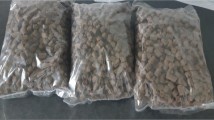Abstract
A transpiration method was used to evaluate the Henrian activity coefficient of Pb (γ°Pb) in Cu-Fe mattes and white metal. Values for the activity coefficient of Pb (γ Pb) have been evaluated as a function of the Cu/Fe molar ratio from 1 to ∞, as a function of the sulfur deficiency (defined as SD=X S−1/2X Cu−X Fe, where X 1 is the mole fraction of the ith species) from −0.02 to +0.02, and at temperatures between 1493 and 1573 K. Analysis of γ Pb as a function of the trace element concentration reveals that the activity coefficient is independent of Pb content at weight percents less than 0.2. Dependence of γ Pb on temperature was found to be slight, and as such, comparison of data obtained by other investigators at 1473 K was possible. Agreement in the data is excellent, and all the data have been used to generate the empirical equation
that is valid over the temperature range from 1473 to 1573 K. The experimental results suggest that in high sulfur content melts, lead is stabilized as PbS. The results also reveal that free copper, in sulfur deficient mattes, tends to stabilize Pb, but to a lesser extent than that experienced with excess sulfur in high sulfur melts. Failure to account for sulfur loss can lead to a significant error. This article also presents a method whereby sulfur loss during experiments can be accounted for in computing activity coefficients.
Similar content being viewed by others
References
A. Roine: Metall. Trans. B, 1987, vol. 18B, pp. 213–23.
P.C. Chaubal, H.Y. Sohn, D.B. George and L.K. Bailey: Metall. Trans. B, 1989, vol. 20B, pp. 39–51.
K.W. Seo and H.Y. Sohn: Metall. Trans. B, 1991, vol. 22B, pp. 791–99.
K. Itagaki and A. Yasawa: in Advances in Sulfide Smelting, H.Y. Sohn, D.B. George, and A.D. Zunkel, eds., TMS-AIME, Warrendale, PA, 1983, vol. 1, pp. 119–42.
D.C. Lynch, S. Akagi, and W.G. Davenport: Metall. Trans. B, 1991, vol. 22B, pp. 677–88.
A. Roine: HSC Chemistry for Windows Ver. 2.0, Outokumpu, Pori, Finland, 1994.
X. Zhong and D.C. Lynch: University of Arizona, Tucson, AZ, unpublished research, 1997.
A. Roine and H. Jalkanen: Metall. Trans. B, 1985, vol. 16B, pp. 129–41.
D.C. Lynch: in Extractive Metallurgy of Copper, Nickel, and Cobalt, Vol. I: Fundamental Aspects, R.G. Reddy and R.N. Weizenbach, eds., TMS, Warrendale, PA, 1993, pp. 85–112.
Author information
Authors and Affiliations
Rights and permissions
About this article
Cite this article
Zhong, T., Lynch, D.C. Henrian activity coefficient of Pb in Cu-Fe mattes and white metal. Metall Mater Trans B 29, 429–436 (1998). https://doi.org/10.1007/s11663-998-0121-z
Received:
Issue Date:
DOI: https://doi.org/10.1007/s11663-998-0121-z




